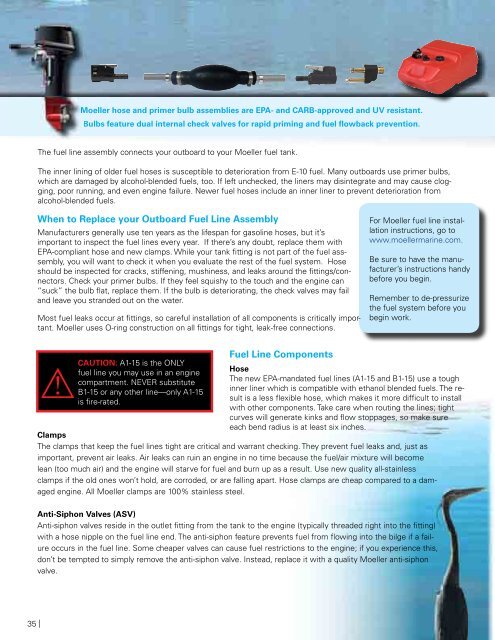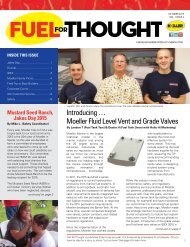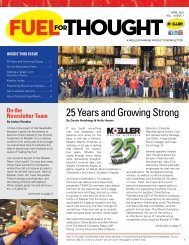2016_catalog_web
Create successful ePaper yourself
Turn your PDF publications into a flip-book with our unique Google optimized e-Paper software.
Moeller hose and primer bulb assemblies are EPA- and CARB-approved and UV resistant.<br />
Bulbs feature dual internal check valves for rapid priming and fuel flowback prevention.<br />
The fuel line assembly connects your outboard to your Moeller fuel tank.<br />
The inner lining of older fuel hoses is susceptible to deterioration from E-10 fuel. Many outboards use primer bulbs,<br />
which are damaged by alcohol-blended fuels, too. If left unchecked, the liners may disintegrate and may cause clogging,<br />
poor running, and even engine failure. Newer fuel hoses include an inner liner to prevent deterioration from<br />
alcohol-blended fuels.<br />
When to Replace your Outboard Fuel Line Assembly<br />
Manufacturers generally use ten years as the lifespan for gasoline hoses, but it’s<br />
important to inspect the fuel lines every year. If there’s any doubt, replace them with<br />
EPA-compliant hose and new clamps. While your tank fitting is not part of the fuel asssembly,<br />
you will want to check it when you evaluate the rest of the fuel system. Hose<br />
should be inspected for cracks, stiffening, mushiness, and leaks around the fittings/connectors.<br />
Check your primer bulbs. If they feel squishy to the touch and the engine can<br />
“suck” the bulb flat, replace them. If the bulb is deteriorating, the check valves may fail<br />
and leave you stranded out on the water.<br />
Most fuel leaks occur at fittings, so careful installation of all components is critically important.<br />
Moeller uses O-ring construction on all fittings for tight, leak-free connections.<br />
For Moeller fuel line installation<br />
instructions, go to<br />
www.moellermarine.com.<br />
Be sure to have the manufacturer’s<br />
instructions handy<br />
before you begin.<br />
Remember to de-pressurize<br />
the fuel system before you<br />
begin work.<br />
⚠<br />
CAUTION: A1-15 is the ONLY<br />
fuel line you may use in an engine<br />
compartment. NEVER substitute<br />
B1-15 or any other line—only A1-15<br />
is fire-rated.<br />
Fuel Line Components<br />
Hose<br />
The new EPA-mandated fuel lines (A1-15 and B1-15) use a tough<br />
inner liner which is compatible with ethanol blended fuels. The result<br />
is a less flexible hose, which makes it more difficult to install<br />
with other components. Take care when routing the lines; tight<br />
curves will generate kinks and flow stoppages, so make sure<br />
each bend radius is at least six inches.<br />
Clamps<br />
The clamps that keep the fuel lines tight are critical and warrant checking. They prevent fuel leaks and, just as<br />
important, prevent air leaks. Air leaks can ruin an engine in no time because the fuel/air mixture will become<br />
lean (too much air) and the engine will starve for fuel and burn up as a result. Use new quality all-stainless<br />
clamps if the old ones won’t hold, are corroded, or are falling apart. Hose clamps are cheap compared to a damaged<br />
engine. All Moeller clamps are 100% stainless steel.<br />
Anti-Siphon Valves (ASV)<br />
Anti-siphon valves reside in the outlet fitting from the tank to the engine (typically threaded right into the fitting)<br />
with a hose nipple on the fuel line end. The anti-siphon feature prevents fuel from flowing into the bilge if a failure<br />
occurs in the fuel line. Some cheaper valves can cause fuel restrictions to the engine; if you experience this,<br />
don’t be tempted to simply remove the anti-siphon valve. Instead, replace it with a quality Moeller anti-siphon<br />
valve.<br />
35 |






